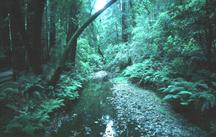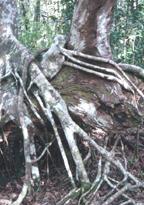|
 Tropical
Rainforest: Plants Tropical
Rainforest: Plants
Although tropical
rainforests receive 12 hours of sunlight daily, less than 2% of
that sunlight ever reaches the ground. The tropical rainforest has
dense vegetation, often forming three different layers--the canopy,
the understory, and the ground layer. Frequently, people think of
the tropical rainforest as a "jungle" where plant growth is dense
even at ground level. However, the canopy created by the tall trees
(100-120 feet) and the understory, prevents sunlight from reaching
the ground. The soil is, therefore, always shaded, and very little
vegetation is able to survive at ground level.
Vegetation can become
dense at ground level near riverbanks and on hillsides. Hillsides
have more plant growth because the angle of the growing surface
allows sunlight to reach lower layers of the forest. Riverbeds break
up the forest canopy so that smaller plants can get the needed sunlight.
 Plant
adaptation Plant
adaptation
Plant survival in a tropical rainforest depends on the plant's ability
to tolerate constant shade or to adapt strategies to reach sunlight.
Fungus is a good example of a plant that flourishes in warm, dark
places created by the forest canopy and understory.
Competition for sunlight
by plants is sometimes deadly. The strangler fig needs sunlight
to grow and reproduce. Seeds falling to the ground quickly die in
the deep shade and infertile soil of the tropical rainforest. So
it has adapted. Its seeds are deposited on branches of host trees
by birds and small animals that have eaten the fruit of the strangler
fig. The seeds sprout and send a long root to the ground. This root
rapidly increases in diameter and successfully competes for the water
and nutrients in the soil. As the strangler fig matures, branches
and leaves grow upwards creating a canopy that blocks sunlight from
the host tree. Additional roots are sent out and wrap around the
host tree, forming a massive network of roots that strangle and
eventually kill the host. Photos
© 2000-www.arttoday.com
Back
| Next
|











